
JOIN US
GET OUR KUNEKUNE
NEWSLETTER
New and highly discounted products, fresh and hot stories & useful information
Breeding & Farrowing KuneKune Pigs
Breeding and Farrowing KuneKunes can be such an amazing experience for the whole family. Tips for Breeding KuneKune pigs that are exceptional while learning strategies for success. What age do KuneKune pigs breed and other frequently asked questions. Learn about Breeding and farrowing KuneKune pigs and what to expect when your KuneKune piglets arrive.
There is a lot to learn about breeding and farrowing KuneKune pigs. This discussion will cover preparing for the piglets' arrival and farrowing a litter.
Important Considerations on when KuneKunes are Ready for Breeding
KuneKunes are slower-growing pigs. Boars (males) can usually reach breeding age around 7-12 months. The gilts (females that have not farrowed a litter before) reach breeding age at 12 + months depending on their size and bloodlines. Usually, males and females can be housed together until the gilts begin to cycle around 6-8 months of age. Consequently, I have seen a boar piglet breed a sow at only 7 months old. So, you must make your general rule of thumb to remove boar piglets by 6 months of age. By moving them apart it protects the gilt from getting pregnant until the time you want to breed them, and it also helps them “miss” each other for when you do wish to breed them.
Giving Females Extra Time
It can be worth the extra time if you allow girls to "mature" more than just breeding at 12 months. I hear that all the time. My advice has always been that they are worth the wait to breed them depending on their size and bloodlines at 14-16 months of age. At that age, they are more mature mentally, not just physically, and usually, they will have a better litter size and you will lose fewer piglets. So, to me, it is worth the extra couple of months to help for a successful breeding and farrowing experience.
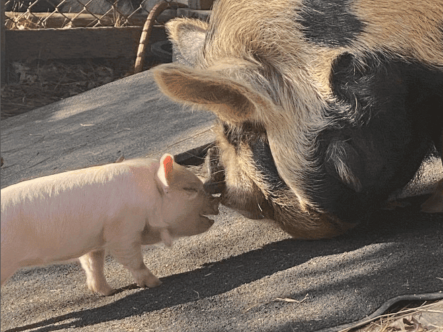
Considerations Before Breeding KuneKune Pigs
Before breeding you want to give the gilt her shots as instructed by the veterinarian of your choice. For this article I will advise you on what I do for my breeding program but, please never substitute this over what your vet suggests to you. I use Toxiac AD & E (or Rhini Shield TX4) and deworm with Ivermectin (injectable) at least a week or two before the gilt goes to the boar. Consider using Farrowsure Gold before breeding as well. Please keep in mind that this means that they already had their first two doses as younger pigs and already are on a regular schedule for deworming which is every 6 months.
Accessing the Gilt or Sows Weight and using the Flushing Technique
Above all, I want to assess the gilt's weight and make sure she is in optimal health. You can also “flush” the gilt before breeding which is “said” to give you more piglets. Flushing is where you increase the gilts food so that her body knows that food is plentiful and therefore, she can sustain the pregnancy. A gilt that is not healthy will not usually conceive. I have experienced many times in mentoring other KuneKune Breeders who were not properly feeding their KuneKunes that they also did not conceive. The way it was explained to me by my mentor is if the gilt does not feel like there is enough food to sustain a litter, they will not get pregnant. That also works the other way too, if they are older say 2+ years and above they may have a harder time conceiving as well. KuneKune Pigs are a lard animal and at that age if overweight, they may have fat around their ovaries. So, keep in mind that an overweight gilt may have trouble conceiving.
What happens when I keep a boar and gilt together too long?
Another consideration is if you have been keeping your boar and gilt or sow, together for extended periods, they may become more like brother and sister. This happens because the gilt/sow is more dominant than the boar usually in the social structure of the herd. She may have reprimanded him many times throughout their prolonged periods together. This lessens his confidence in breeding and although they present two proud testicles and are intact, they may refuse to mount a dominant female that they have grown up with. Please keep this in mind. This is another reason to remove your boars and protect their egos from dominant females. This will help you be more successful in breeding and farrowing.
Watch for signs of Heat
You want to keep an eye on the gilt for her to cycle and if you are lucky, you will see the breeding. KuneKunes tend to be very private breeders. If you do not see the breeding it does not mean it did not happen. You write this date down so as not to forget it and add 116 days for her “due date”. You can also use our handy Gestion Calculator by clicking the button below.
If you did not see the breeding, you should have looked every day to see when she began to swell. A helpful suggestion is to take a photo every day of her vulva. You may look ridiculous to nearby neighbors, but it is helpful to compare those photos to each other so as not to miss the swelling. This worked well for me and can be a great tool.
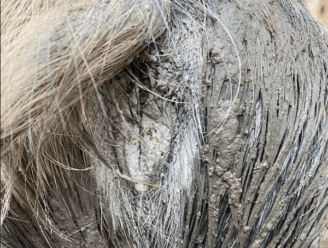
How Long are KuneKunes pregnant? What is a KuneKune Gestion Period?
KuneKunes are pregnant for 3 months, 3 weeks, and 3 days. That is 116 days. During this time, you will want to begin the farrowing quarters if you have not already done it. Moms will need a nice area for farrowing their babies in a draft-free environment. If you are farrowing in the winter, you will want to have electricity for heat lamps and a source of heat should you be in an area that needs heat. We use our heat lamps on a thermostat so that the heat lamps kick on and off automatically when the temperature drops below the temperature, I set it to.
This is a very convenient way to run the heat lamps. We also live in Virginia and this winter has been a bit extreme in temperatures. We heat our farrowing buildings with a propane heater that is mounted up high so that it sows when making a nest do not sling hay into the propane heaters. Always use caution with heat lamps and heat. The propane heater does keep it nice and cozy for the newborn piglets. Watching the signs will help you be successful in farrowing and not miss this wonderful event.
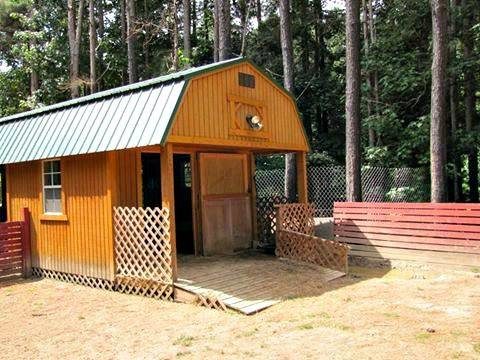
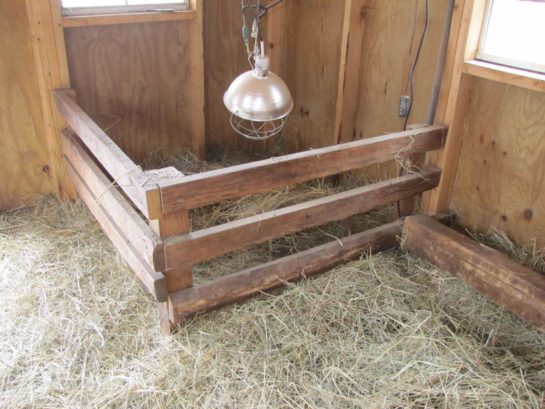
Planning the Farrow Quarters
You will want to plan your pig rails or crush rails as well. In the picture, you can see the creep and the pig rails in our farrowing building. The purpose of these rails is to allow a piglet to “escape” should a mom get close to laying on them. I cannot say that our crush rails have really been used but, sometimes the babies go under them to sleep away from mom. They are supposed to keep Mom from accidentally squishing piglets. Most of the time, the piglets go to the heat lamps to warm and mom to eat. This is a natural pull to the piglets, the source of heat. This also allows moms time to rest undisturbed. I hang my heat lamps over the creep to draw the piglets to this area so that they are not squished. Please make sure that you hang them incredibly carefully. We used small chains, and they were wrapped around the beams inside the building. I also would hang them a second way by their hooks to the chains.
Bedding Considerations
We used pine bedding on the floor of our farrowing quarters to absorb urine as the piglets began to go potty in our early days. I found that when the piglets were born the pine bedding would stick all to them. So, I added hay on top of the pine bedding. Later we switched to just hay as when newborns are born, and mom builds her nest she will bring the pine bedding to the top where it sticks to the wet piglets. We did many trials and errors, and you will find which one works best for you. We even used towels to sit on or for newborn piglets to lay on.
What to do when mom gets close to the big farrowing day.
Five weeks before the mom farrows you will want to give her another dose of Rhini Shield TX4 or Toxiac AD & E whichever one you used before you bred her. Then another dose two weeks before her due date. This helps pass immunities over to the babies when they begin to nurse in her milk. Now you are awaiting that exciting day of farrowing.
When mom gets close to farrowing, most will begin to paw and dig at the hay. They will rearrange it, and some even make a big bowl in the hay. You will begin to see her vulva swell and her teats become elongated. You can even feel the babies inside kicking and turning. I still get extremely excited to feel that. I will usually wipe mom off with a damp rag with a disinfectant as well just to get off excess dirt. In the summer months, while they lay around in mud puddles all day long, that can be something you repeat quite frequently. Have lots of towels or shop rags handy. At least they are re-usable.
Amazing piglets a birth can...
When I witnessed the birth of piglets, I was astounded by what I saw. Each tiny piglet emerged into the world with their cords already cut and free from the protective sack. This incredible sight stood in stark contrast to my previous experiences of raising Australian shepherds for over a decade. With the puppies, it was common to find remnants of the sack clinging to their fragile bodies, requiring gentle cleaning. However, with the piglets, I discovered that they possess an innate ability to dry off on their own, without any interference from humans.
Within mere moments of their arrival, these remarkable piglets were already up on their feet, ready to explore the world around them. It was a sight that left me in awe, as I had grown accustomed to the sight of newborn puppies who were completely dependent on their mother for the first couple of weeks. These puppies would spend their initial days scooting around, unable to see or hear their surroundings.
In contrast, the piglets wasted no time in showcasing their incredible independence.
With their eyes wide open and ears alert, the piglets wasted no time in exploring their surroundings. It was a sight that filled me with wonder and admiration for these resilient creatures. Witnessing their rapid development and ability to walk and even run so soon after birth was truly a sight to behold. The energy and vitality exuded by these newborn piglets were nothing short of astonishing.
It Changed My Life
The experience of witnessing the birth of piglets has forever changed my perception of the early stages of life. It has opened my eyes to the incredible diversity and adaptability of different species. The piglets' ability to navigate their environment so soon after birth serves as a testament to the wonders of nature and the innate instincts ingrained within these remarkable creatures.
Birthing and Human Children
If you have children, sows are exceptionally tolerant of their presence in the farrowing quarters. However, it is crucial to ensure that your children remain quiet and still so as not to disturb the mother while she is diligently laboring to bring the adorable KuneKune piglets into the world. Just imagine giving birth in a hospital while your other children are energetically running around - it would certainly be quite chaotic! Well, the same principle applies to the sows.
It is always important to exercise caution, especially when dealing with first-time mothers during farrowing. Pay close attention to the visual cues displayed by the mother to gauge her comfort level.
In my personal experience, my granddaughter, whom we were raising, had the privilege of witnessing the births of both puppies and KuneKunes from the age of 2 and onwards. Having been raised alongside the pigs, she had developed a deep understanding of them, much like myself. Therefore, it ultimately comes down to your judgment and familiarity with your children.
I cherished having my granddaughter present during the births, although my husband's presence often frayed my nerves. He was simply too noisy for my liking and tended to bother me, rather than the expectant mother. Thus, he rarely attended a birth. Finding the perfect balance that works for you is essential to ensure a successful breeding and farrowing experience. So, should you let your children stay or have them leave? The decision rests in your hands.
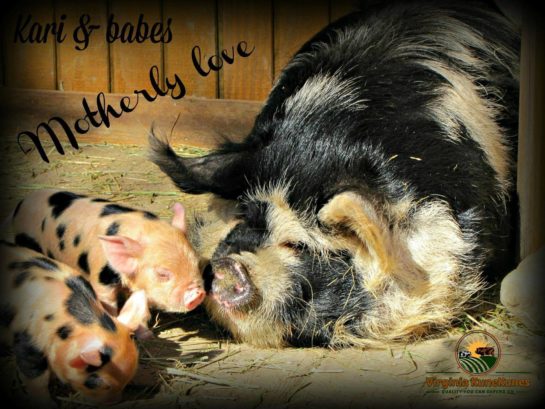
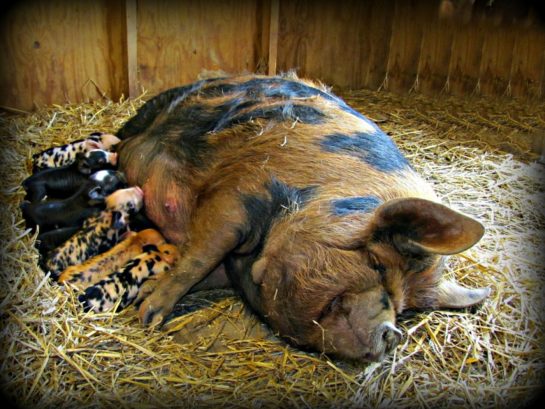
The Afterbirth
First, when the mom has finished farrowing, she will deliver the afterbirth. Likewise, at times you may see two afterbirths. That is each side of the uterine horn. I would clean up and dispose of that quickly after that comes out. Moms will sometimes attempt to eat the afterbirth. While it is said it is good for them to each to replenish themselves, I have had one get choked on it and die. So, I always cleaned it up. Likewise, I tend to err on the side of caution.
Once the afterbirth is passed that is usually how you will know that the birthing process is over. Occasionally, a mom will deliver one horn after birth and have more piglets, and then the other side of the horn after birth will come out. Consequently, I have only had this happen 1-2 times since I have been farrowing piglets. The afterbirth will be shaped like “Y” if spread out. Meanwhile, I must admit that this is my least favorite thing to do. I am a bit squeamish about that one thing. I am not sure why but, it is gross and one of my least favorite things to do but watch how quickly I clean it up if a mom is going to get it before I do.
The KuneKune piglets Cords
Wait For 2-3 Hours
First, it is important to wait for the piglets to be a couple of hours old before taking any action. This allows them to adjust to their new environment and ensures that they are strong enough to handle any procedures that may be necessary. Once the appropriate time has passed, (usually around 2 hours) the next step is to carefully cut their umbilical cords shorter. This is done to prevent any potential accidents or discomfort for the piglets.
By shortening the cords, they can move around more freely without the risk of stepping on or getting tangled in them. You will want to cut the cords approximately 1-2 inches from the belly. Additionally, this helps to avoid any complications that may arise from the cords being wrapped up in the hay or entangled with their litter mates. Preventing umbilical hernias.
How to Handle the Piglet Cords
After the cords have been cut, it is advisable to spray the cut point with iodine spray. This serves as a disinfectant and helps to prevent any infections or complications that may arise from the procedure. The iodine spray acts as a protective barrier, ensuring that the piglets' umbilical cords heal properly and remain free from any harmful bacteria.
Taking the necessary steps to ensure the well-being of newborn piglets is crucial. By waiting for the piglets to reach a suitable age, cutting their umbilical cords shorter, and applying iodine spray, we can provide them with a safe and healthy start in life. Additionally, the remarkable maternal instincts of KuneKune mothers contribute to the overall well-being and development of their offspring, creating a harmonious and nurturing environment for these adorable creatures.
KuneKune Moms and Their Piglets
It is worth noting that KuneKune mothers are known for their exceptional mothering skills. They have the instinct to care for their offspring and will often call their babies to them when it is time to eat. You will observe how a mom will call her piglets and only put down the head part of the body and ensure that the piglets are out of the way before laying down. This is not always the case but, is in more times than not. This is down so she does not accidentally squish a newborn piglet.
This nurturing behavior is accompanied by gentle noises that the mother pig makes while her babies nurse. Some believe that these sounds can be interpreted as the mother singing to her precious piglets, creating a bond and fostering a sense of security and comfort. I must admit that this is one of my favorite things to listen to and watch. This "singing" actually helps the mom release their milk supply for the piglets.
Children with the Breeding & Farrowing KuneKune pigs
If you have children, this is an amazing experience to share with them. Witnessing the birth of KuneKune piglets is truly a remarkable event that leaves a lasting impression on young minds. The sheer wonder and awe that fills the air as the mother pig brings new life into the world is something that cannot be replicated. It is a moment of pure magic, where the circle of life unfolds right before your eyes.
KuneKune's mom graciously welcomes your presence during this extraordinary process. She understands the importance of educating children about the miracle of life and allows them to observe the entire birthing journey. The mother pig's gentle nature and willingness to let you interact with her piglets further enhance the experience, creating a unique bond between humans and animals.
Valuable Lesson for Children
This incredible opportunity serves as a valuable lesson for children, teaching them about the beauty and fragility of life. They learn firsthand about the cycle of birth, growth, and nurturing, gaining a deeper appreciation for the interconnectedness of all living beings. It instills in them a sense of responsibility and compassion towards animals and nature.
As someone who has dedicated many years to raising KuneKunes, I have developed a profound admiration for the birthing process. It is a privilege to be present during these moments, not because the mother pig requires assistance, but because I genuinely cherish the chance to be a part of such a miraculous event. The arrival of new life fills me with joy and gratitude, reminding me of the wonders that exist in our world.
Amazing Experience
Breeding and farrowing are truly remarkable experiences that allow us to witness the miracle of birth firsthand. It is a time of anticipation, excitement, and wonder as new life is brought into the world. The bond between a mother and her offspring is forged during this process, creating a strong foundation for their future relationship.
As you embark on this journey, we encourage you to immerse yourself in the beauty of nature's cycle. Take the time to observe and learn from the animals, as they instinctively navigate through the stages of pregnancy, labor, and delivery. Witnessing the strength and resilience of these creatures is a humbling experience that reminds us of the incredible power of life.
In Summary
Whether you choose to involve your family in this process or take on the responsibility yourself, we hope that you find joy in every step along the way. Share the excitement with your loved ones, allowing them to witness the miracle of birth and instilling in them a sense of awe and appreciation for the wonders of nature.
If you decide to undertake this journey alone, know that you are not alone in spirit. We stand beside you, offering our support and encouragement as you navigate through the challenges and triumphs of breeding and farrowing. Remember to take care of yourself during this time, as your well-being is crucial to the success of the process.
May your breeding and farrowing experience be filled with moments of pure joy and fulfillment. May you witness the birth of healthy, thriving offspring and feel a deep sense of pride and accomplishment. Embrace this opportunity to connect with nature and celebrate the circle of life. We wish you all the best and hope that this experience leaves a lasting imprint of happiness and gratitude in your heart.
Frequently asked questions?
What age do KuneKune pigs breed?
Male piglets can become sexually active at 6-8 months of age but, it is best to let them mature to 12 months before breeding them as this gives their sperm time to be more fertile. Gilts can become sexually active at 8-10 months but, it is best to give them more time to mature physically and mentally for a successful birth. Usually, gilts are bred at 14-16 months of age although some breeders do breed at 12 months of age. It depends on the gilt, her size, and her mental maturity.
Breeding Exceptional KuneKune Pigs:
Strategies for Producing Healthy and Thriving Offspring
In the world of KuneKune pig breeding, the goal is simple: to produce
exceptional offspring that are healthy, thriving, and sought after by pig
enthusiasts. However, achieving this goal requires careful planning, strategic
breeding strategies, and a commitment to the overall well-being of the animals.
In this article, we will explore some proven strategies for breeding
top-quality KuneKune pigs destined for success.
One key factor in producing healthy offspring is selecting the right
breeding pairs. It is essential to choose pigs that possess desirable traits
such as good conformation, sound temperament, and optimal health. By carefully evaluating the genetics and lineage of potential breeding stock, breeders can increase the chances of producing exceptional offspring.

Nutrional Considerations
Another crucial aspect of successful pig breeding is ensuring optimal nutrition and healthcare for both the breeding stock and their offspring. Providing a balanced diet, regular veterinary care, and an appropriate environment is vital for the overall health and well-being of the animals. By implementing these strategies and continuously improving breeding practices, breeders can produce KuneKune pigs that not only meet but exceed expectations. With careful planning and dedication, breeding exceptional KuneKune pigs is not just a dream; it can become a reality.
How to achieve exceptional quality pigs?
So, how do achieve this? Well, education is the key! Read, read, and read. Do your homework. For IKKPS, we put a ton of information into everyone’s hands to learn more about the genetics, conformation, and skill of successfully raising this breed. So, take advantage of this. Join the KuneKune registry and interact with other breeders during our monthly educational meetings. Each month there is a new topic.
You get what you pay for!
Do not skimp when looking at purchasing your breeding stock. You do get what you pay for. Is the price low? There is a reason for that. If it sounds too good to be true, then most likely it is. When you purchase high-quality pigs for your breeding program the results you get are well worth the investment. Look for purebred, registered KuneKunes and understand the breed standards. Understand conformation and what good conformation looks like.
Breeding exceptional KuneKune pigs is not just about producing cute piglets. It goes beyond that. Breeding exceptional pigs is about ensuring that the next generation possesses the best traits, both physically and temperamentally. The goal is to produce better offspring than the parents or at least equal to the parents. By focusing on breeding exceptional pigs, breeders can contribute to the overall improvement of the KuneKune pig breed.
Purchase Healthy Breeding Stock
One key factor in producing healthy offspring is selecting the right breeding pairs. It is essential to choose pigs that possess desirable traits such as good conformation, sound temperament, and optimal health. By carefully evaluating the genetics and lineage of potential breeding stock, breeders can increase the chances of producing exceptional offspring.
When selecting breeding stock, it is important to consider the overall health and potential genetic issues that may be present. Breeders should conduct thorough health checks, including screening for common genetic disorders in KuneKune pigs. By selecting pigs with excellent health records and without any known genetic issues, breeders can minimize the risk of passing down undesirable traits to the offspring.
Don't be shy. Ask for health records, vaccinations, and deworming. Ask about the feed they use and utilize the KuneKune Registries to look at past litters if this is a KuneKune that has been bred before. The registry will have records of the number of piglets they have had before and how many of them were registered as breeding stock.
IKKPS and Pictures
In IKKPS, we have pictures in our herd book and on the pig's pedigree information and the official registration certificate. This can be invaluable in seeing what parents and offspring look like that come from their breeding programs when we cannot see them yet in person. Ask for videos on any potential ones that you are considering.
Consider Temperament
Another crucial aspect of selecting high-quality breeding stock is evaluating the temperament of the pigs. KuneKune pigs are known for their friendly and docile nature, so it is important to choose the breeding stock that exhibits these traits. Pigs with a good temperament are not only easier to handle and manage but also tend to produce piglets with similar temperaments, making them more desirable to potential buyers.
When it comes to evaluating temperament, there are several factors to consider. Firstly, observing how the pigs interact with humans is essential. Friendly pigs will approach humans without fear or aggression, allowing for easier handling and interaction. Additionally, pigs that are comfortable being touched and handled are more likely to pass on these traits to their offspring.
Pig Behaviors to Each Other
Another aspect to consider is the pigs' behavior towards other animals. Pigs that are calm and non-confrontational with other pigs or livestock are more likely to create a harmonious environment within the herd. This is important for minimizing stress and potential conflicts, which can negatively impact the overall well-being and productivity of the pigs.
You will learn much by just watching and observing the interactions between members of the herd. For instance, you will see who is more dominant and who may be lower on the hierarchy of the herd.
Observing in New Environments
Furthermore, observing the pigs' response to new environments and stimuli is crucial. Pigs that adapt well to changes and remain calm in unfamiliar situations are more likely to pass on this resilience to their piglets. This is particularly important for pigs that may be transported or exposed to different environments throughout their lives.
In addition to direct observation, it can also be helpful to gather information from previous owners or breeders about the temperament of the potential breeding stock. This can provide valuable insights into the pigs' behavior and temperament over time, allowing for a more informed decision. By carefully evaluating the temperament of the breeding stock, breeders can ensure that they are selecting pigs that not only possess the desired traits but also have the potential to pass them on to future generations. This ultimately contributes to the production of high-quality piglets with excellent temperaments, increasing their market value and desirability to potential buyers.
Breeding Considerations
Breeding season plays a vital role in the success of pig breeding. Proper preparation is essential to ensure that both the sow and the boar are in optimal condition for breeding. Before the breeding season begins, it is important to assess the health and nutritional status of the breeding stock. Sows should be in good body condition, neither too thin nor overweight, to ensure successful conception and a healthy pregnancy. A balanced diet rich in essential nutrients, vitamins, and minerals can help prepare the sow's body for the demands of pregnancy. Additionally, regular exercise and access to a clean and comfortable environment contribute to the overall well-being of the sow.
For boars, it is important to ensure that they are in prime condition before breeding. Make sure they have both testicles that they are even and no scrotal hernias are present. Regular exercise, a nutritious diet, and proper healthcare are essential to optimize their fertility. Boars should undergo regular health checks and be evaluated for any potential reproductive issues that may affect their ability to breed successfully.
Natural Mating versus Artificial Insemination (AI)
Once the breeding season is underway, breeders need to employ effective breeding techniques and considerations to maximize the chances of successful conception. There are different breeding methods to consider, including natural mating and artificial insemination, each with its advantages and challenges. Natural mating allows for a more natural and instinctual breeding process, but it requires careful supervision to ensure that the mating is successful. Breeders should monitor the mating process closely to ensure that the sow is receptive and that the boar's behavior is appropriate. It is also important to provide a safe and comfortable environment for the mating process to reduce the risk of injury to the animals involved.
Artificial insemination (AI) is another newer option for breeders, offering more control over the breeding process. AI allows breeders to select specific genetic traits and use semen from proven boars. It also eliminates the need for physical contact between the boar and the sow, reducing the risk of injury and disease transmission. However, AI requires specialized knowledge and equipment, making it more complex and expensive to implement.
Pregnancy and prenatal care for KuneKune pigs
Once the breeding is successful, the next stage is the pregnancy and prenatal care of the sow. During pregnancy, it is crucial to provide the sow with proper nutrition, regular veterinary care, and a stress-free environment. A balanced diet with adequate nutrients is essential to support the sow's growing fetus and maintain her overall health. It will be important to ensure the show has been given all necessary deworming and vaccinations before breeding. Likewise, you must not increase the feed during pregnancy of the sow or gilt to avoid issues during farrowing.
Regular veterinary check-ups are not usually necessary to monitor the progress of the pregnancy and address any potential complications unless you do not have a mentor or are new to the breed. Breeders should work closely with their veterinarians to ensure that the sow receives the necessary vaccinations and treatments to prevent diseases that may harm both the sow and the developing piglets.
Creating a stress-free environment for the pregnant sow is also important. Stress can negatively impact the sow's health and the development of the piglets. A clean, quiet, and comfortable space for the sow to nest and rest can contribute to a successful and stress-free pregnancy.
Ensuring the health and growth of piglets
After a gestation period of approximately 116 days, the sow will give birth to a litter of piglets. Proper care and management of newborn piglets are essential for their survival and growth. Breeders should ensure that the farrowing area is clean, warm, and free from any potential hazards that may harm the piglets. The piglets should have access to the sow's milk as soon as possible after birth. Colostrum, the first milk produced by the sow, is rich in essential nutrients and antibodies that provide vital immunity to the piglets. Ensuring that each piglet receives adequate colostrum within the first few hours of birth is crucial for long-term health.
Breeders should also monitor the piglets closely for any signs of illness or weakness. Providing appropriate medical care and addressing any health issues promptly can significantly improve the chances of survival and overall well-being of the piglets.
As the piglets grow, proper nutrition and healthcare remain essential for their optimal development. Breeders should provide a balanced diet that meets
the nutritional requirements of the growing piglets. High-quality commercial pig feed specifically formulated for piglets can help ensure that they receive
the necessary nutrients for healthy growth. How you feed your piglets will have a significant impact on how they turn out.
Additionally, breeders should provide an appropriate environment for the piglets to thrive. Sufficient space, proper ventilation, and access to clean water and bedding are all key factors that contribute to the overall well-being and growth of the piglets.
Tips for raising exceptional KuneKune piglets.
Raising exceptional KuneKune piglets goes beyond providing basic care and nutrition. Breeders should strive to go the extra mile to ensure that the piglets receive the best possible care and start life. Here are some tips for raising exceptional KuneKune piglets:
Socialization
Expose the piglets to different environments, sounds, and people from an early age to promote their social skills and adaptability. Have male and female members of your family handle the piglets regularly. Allow the children to interact with the piglets.
Training
Keeping your sow with her piglets for at least 7 weeks or longer will provide them needed valuable training. The sow will teach her piglets manners and weaning too early can prevent them from learning these lessons.
Enrichment
Provide stimulating toys, objects, and activities to keep the piglets mentally stimulated and prevent boredom. This can be as easy as adding milk jugs that have food in them and as the root around the food falls out.
Record Keeping
Record Keeping: Maintain detailed records of each piglet's growth, health, and lineage. This information can be valuable for future breeding decisions and potential buyers. The better records you keep the easier the registration process will be for you. Do your litter notification while it is fresh in your mind.
Networking
Connect with other KuneKune pig breeders and enthusiasts to exchange knowledge, experiences, and potential breeding opportunities. This is an area that sets IKKPS apart from other registries. We have networking opportunities every month for you to learn and interact with fellow breeders. These are called continue learning meetings and are hosted virtually to elevate the costs involved in traveling as a breeder we know you don’t have time to be away from your pigs and piglets.
Know the Breed and Breed Standards
Have a clear understanding of the breed, KuneKune pig colors, and the KuneKune breed standard. This will help you to determine what is worthy of registration and what should be utilized for other purposes. Take the time to educate yourself or join IKKPS so we can help educate you.
Registrations and Sales Contracts
IKKPS customizes your sales contract for you complete with your logo, name, farm name, and contact information. This helps you look very professional in the eyes of your buyer. Make sure to take care of your customers by following through with their registrations. Even a person with a piglet that is not breeding deserves to have the pedigree of a grazing pig so they have all the information about their piglet. Again, this helps you look professional to your buyers. After all 2 membership levels are free for all your registrations, why would you not want to help track the breed and look professional to your buyers who will return to you when treated right.
By following these tips, breeders can raise exceptional KuneKune piglets that stand out from the crowd and attract potential buyers who value well-rounded and socially adaptable pigs.
Additional Articles you may find helpful
Registry Office
17500 Hamilton Arms Court Dewitt, VA 23840